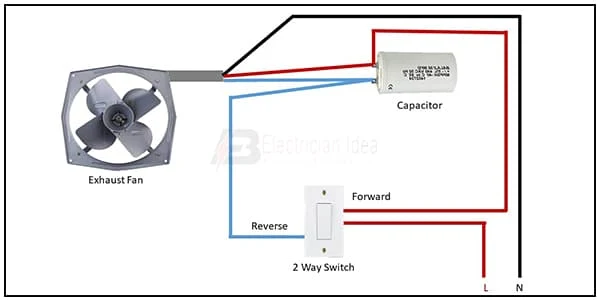Exhaust Fan Reverse Forward Wiring:
This diagram shows how to connect the Exhaust Fan Reverse Forward Wiring. In this circuit diagram, we just use an exhaust fan, a capacitor, and a 2-way switch. First, we need to connect the neutral wire to the exhaust fan then the phase wire to the switch then from the switch to the capacitor connection. And lastly, we connect the capacitor connection with the exhaust fan. If you want to see this circuit animation video please check our youtube video.
Diagram of Exhaust Fan Reverse Forward wiring:
Components Need for this Project:
You can get the components from any of the sites below:
- Exhaust Fan [See Buy Click Amazon]
- Capacitor [See Buy Click Amazon]
- 2-Way Switch [See Buy Click Amazon]
Read Also:
Components used to make the Exhaust Fan Reverse Forward Wiring:
01. Exhaust Fan
 |
| Fig 2: Exhaust Fan |
02. Capacitor
 |
| Fig 3:Capacitor |
03. 2-Way Switch
 |
| Fig 4: 2-Way Switch |
Thank You for visiting the website. Keep visiting for more Updates.
Frequently Asked Questions
As the weather cools down, switch the fan into reverse mode to help distribute warm air that has risen to the ceiling, ensuring that every corner of your room stays cozy or warm. With our reversible exhaust fan, you could save on energy costs while enjoying optimal comfort in any season.
This one controls the direction of the spin of the fan blades. In the majority of cases, ceiling fans are spinning to blow air downward. You could reverse that via the toggle switch and have the blades blowing air upward toward the ceiling.
When you switch the direction that your ceiling fan the blades turn (so that they are spinning clockwise), and that cold air is drawn upward. This updraft forces the warmer air back down toward you or your family.
The blades of the reverse pitch fan are unique in that they are rotated on their own axis to change the pitch or reverse through the cross position. This guarantees the air will always be increased or be in the optimum position to produce maximum airflow. This is in both the cooling and cleaning of the modes.
Homeowners are always looking for ways to save on their energy bills, but they don't often think of their ceiling fan as a way to do it. Warm air naturally rising to the ceiling and reversing the way your blades turn pushes the warm air down.


Post a Comment
Do leave your comments